Menu
Australia


What is GRANDER®?
The GRANDER® Effect
About GRANDER®
Water Research
› GRANDER® Research Concept
› Basic Research
› Findings & Results as of 2019
› Wetsus
› IPF Research at GRANDER®
› Applied Water Physics
› Prof. Dr. IR. Cess Buisman
› Methods of Measurement in Water Analysis
› Water Symposium - Research and Speakers
› External Research
› Internal Research
› Commissioned Research
› Basic Water Research
Findings & Results as of 2019
Summary of research findings (as of 09/2019), sources, and downloads:
Free downloads:
Two questions present ever since GRANDER® water revitalization was discovered have recently been gaining attention: how does GRANDER® water revitalization work, and what is the scientific explanation for the witnessed effects?
Daily use and numerous positive testimonials documented empirically spoke a clear language decades before a scientific explanation was found.
Thanks to newly established branches of research, among them applied water physics (1) and improved water analysis procedures (2), the fundamental mechanisms as well as individual factors of GRANDER® water revitalization are today comprehensively understood, verified, and replicable in the laboratory.
Applied water physics is the scientific branch dealing with the fundamental properties of water, among them its interaction with electric, magnetic, and electromagnetic fields, and the impacts of these interdependencies on living organisms such as bacteria.
A wealth of research has explored the effects of the magnetic or electromagnetic treatment of water in the past 40 years, as is witnessed in more than a hundred papers and reports on this topic (example: extract (10–29)).
For many years, the scientific community was very doubtful concerning the proposition that magnetic fields influence hard water and thus the structure and morphology of the crystallization of calcium carbonate. This was mainly due to the fact that no plausible mechanism was known that could explain the persisting effect of magnetic fields even after the exposition.
For this reason, the application of this principle was controversial, not only with regard to GRANDER® water revitalization.
An interdisciplinary research cooperation encompassing several European universities and research institutions (3) realized in the framework of WETSUS – European Centre of Excellence for Sustainable Water Technology, produced a breakthrough in the understanding of magnetic water treatment (MWT) based on principles of water physics. (4)
The research findings of Dr. Elmar Fuchs (5) and his team/WETSUS (6), see ‘Strong Gradients in Weak Magnetic Fields Induce DOLLOP Formation in Tap Water,’ were verified in a peer-review process. (7)
In 2012, Coey proposed a theory explaining the mechanism of magnetic water treatment based on the gradient of the field used instead of its absolute force.
Recent findings of the ‘Applied Water Physics’ research group at WETSUS (Martina Sammer, Cees Kamp, Astrid H. Paulitsch-Fuchs, Adam D. Wexler, Cees J.N. Buisman, and Elmar C. Fuchs) build on the discovery that calcium carbonate nanoparticles (‘DOLLOPs’) contained in tap water reorganize themselves under certain conditions (which are, inter alia, caused by the magnetic gradient) and in this process change the environmental factors for dissolved substances (such as lime). (8)
The study shows an increase of nm-sized pre-nucleation clusters (dynamically ordered liquid-like oxyanion polymers or ‘DOLLOPs’) caused by the exposition to a magnetic field. This effect is in line with Coey’s theory, showing that it is also applicable to very weak magnetic fields provided strong gradients are contained.
Advanced research methods open up new opportunities in modern water analysis. This applies to trace analysis, which is used to determine the concentration of materials or substances (pg/l), as well as to microbiological testing, for instance for detecting the number of bacteria in water within one hour.
Conservative methods take 72 hours to establish the total bacterial count in potable water. What is more, only approx. 1% of the existing bacteria can be made visible while the remaining 99% stay obscured.
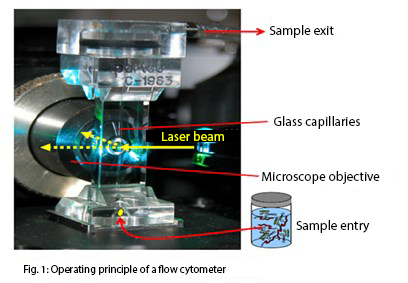
Flow cytometry takes stock of 99% of the bacteria in the water and can even distinguish between living and dead cells. Time required: 1 hour
In flow cytometry, individual cells flowing past an electric-voltage or light source (laser beams in most setups) at high speed are analyzed. Depending on the cells’ shape, structure, and color, various effects are produced, from which the properties of individual cells can be deduced.
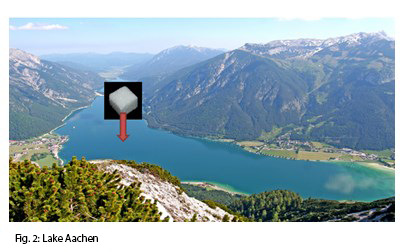
If a single sugar cube were dissolved in Lake Achen, this highly developed measuring technology would be able to detect the sugar.
A recently published peer-reviewed scientific paper presents evidence for the difference between regular and revitalized water. (7)
‘Strong Gradients in Weak Magnetic Fields Induce DOLLOP Formation in Tap Water’
Martina Sammer 1, Cees Kamp 2, Astrid H. Paulitsch-Fuchs 1, Adam D. Wexler 1, Cees J. N. Buisman 1 and Elmar C. Fuchs 1*,
1 Wetsus, European Centre of Excellence for Sustainable Water Technology, Oostergoweg 9, 8911 MA Leeuwarden, The Netherlands; martina.sammer@wetsus.nl (M.S.); astrid.paulitsch-fuchs@wetsus.nl (A.H.P.-F.); adam.wexler@wetsus.nl (A.D.W.); cees.buisman@wetsus.nl (C.J.N.B.)
2 Kamp Consult, Deventerweg 81, 7203 AD Zutphen, The Netherlands; ceeskamp@xs4all.nl
*Correspondence: elmar.fuchs@wetsus.nl; Tel.: +31-58-284-3162
Academic editor: Wilhelm Püttmann
Received: 21 January 2016; accepted: 23 February 2016; published: 3 March 2016
Results:
These phenomena could be observed using three independent research methods.
An AC current is generated in a measuring cell filled with the water to be tested. In doing so, the AC current’s frequency is modified, and the electrical AC resistance (impedance) and the phase shift of the sample are established.
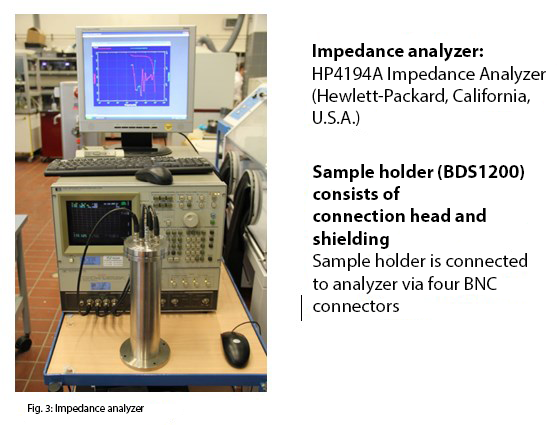
Varying with frequency, significant differences between samples of regular water (8) and water revitalized with GRANDER® could be observed:
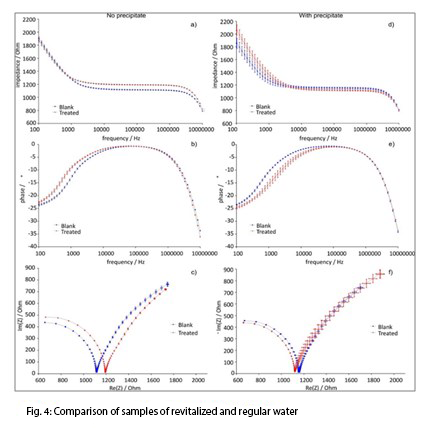
Note: the proposed DOLLOP formation was tested in at least 16 independent experiments. 12 measurements per experiment, each encompassing complex impedance at 65 frequencies, measurement of two parameters (phase and impedance) per frequency. (8)

The number of calcium carbonate nanoparticles (DOLLOPs) was measured using flow cytometry. (8)
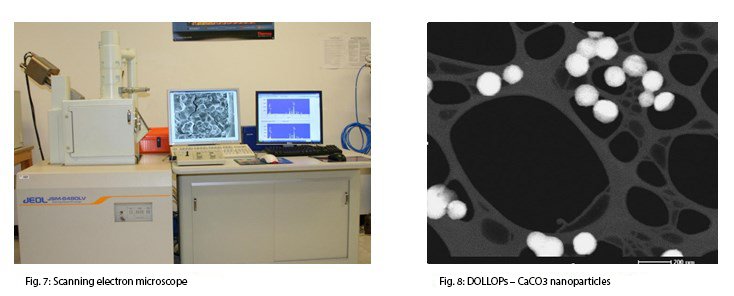
Following a revitalization of the water with GRANDER®, DOLLOP formation was increased. DOLLOPs can act as crystal nuclei, and, as such, influence lime deposit behavior. (8)(9)
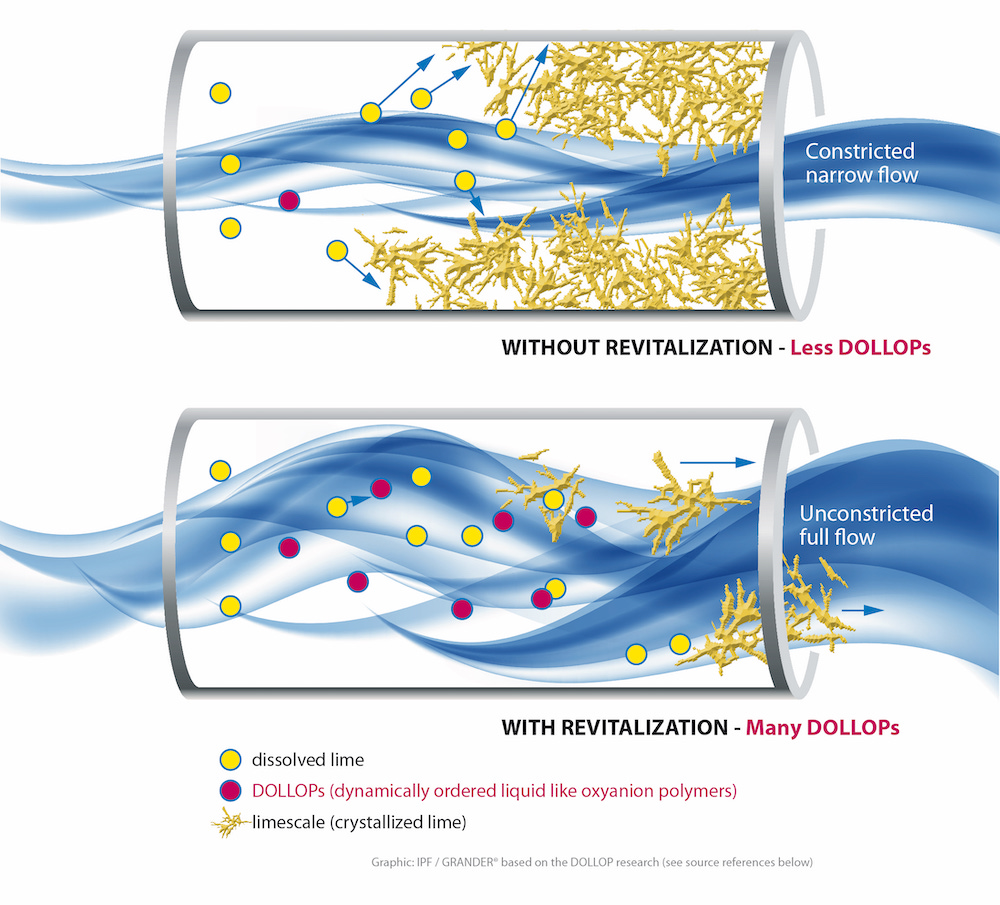
Fewer DOLLOPs without Revitalization
Dissolved lime crystallizes on pipe walls, gradually constricting the pipes (9)
A crystallization of dissolved lime on pipe walls produces detrimental effects such as a constriction of pipes and an increase in flow resistance. Moreover, a rougher surface due to lime deposits is good breeding ground for harmful bacteria and biofilms.
Many DOLLOPs with Revitalization
Dissolved lime already crystallizes in the water due to DOLLOPs and is flushed out (9)
In water with a high concentration of DOLLOPs, crystallization starts already in the water and hardly affects pipe walls. As a result, crystals are not deposited on the pipes but are flushed out with the water stream. (8)
The water’s background flora (autochthonous bacteria) works like an immune system. It protects the water from harmful bacteria in a natural way by consuming nutrients due to its activities, depriving unwanted bacteria of their sustenance.
This process is a fierce competition in which usually only ‘healthy’ flora prevails.
Please note that if the system is infiltrated with an excess amount of pollutants, GRANDER® should be combined with conventional water treatment methods to produce the desired effects.
What are the results of increased self-cleaning properties?
Using flow cytometry, it could be shown that GRANDER® water revitalization supports the water’s background flora and thus its resilience.
Example: likelihood of deposit formation
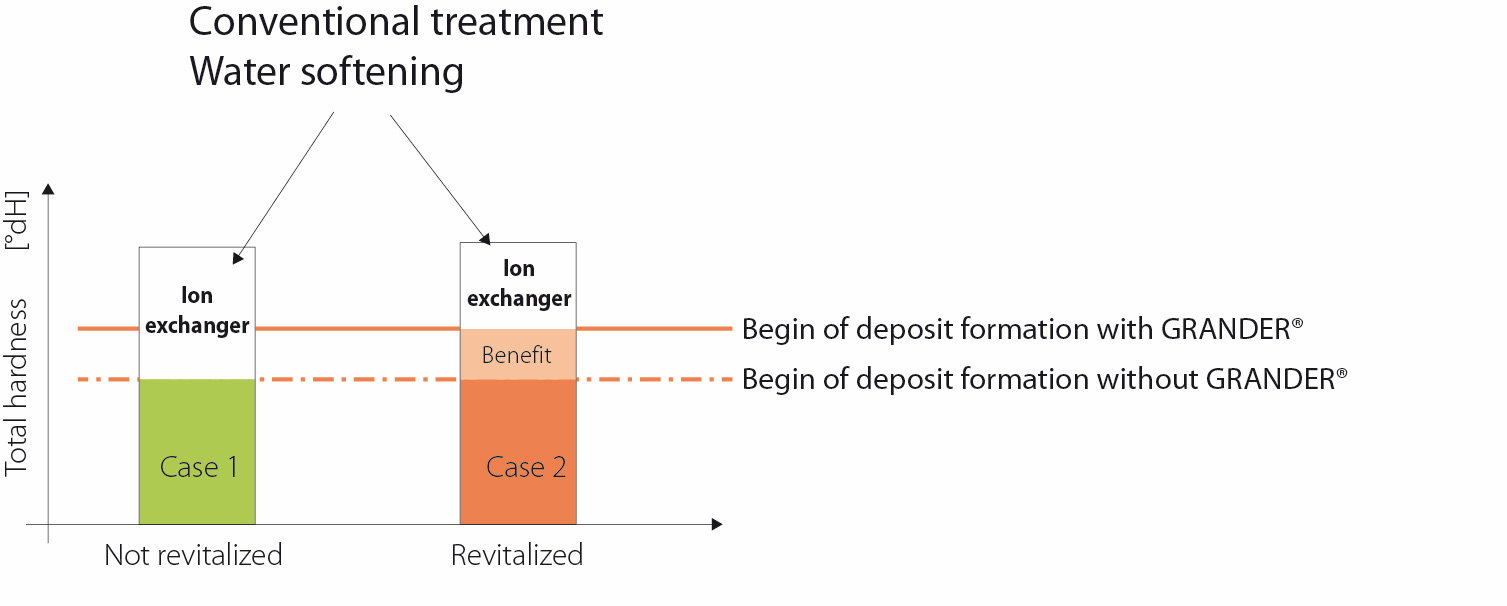
Fig. 1: Likelihood of Deposits
Water can dissolve lime. In this process, the pH value and the temperature are important parameters. The mineral saturation state is another factor determining the amount of lime in solution and the threshold value from which it starts to crystallize.
In revitalized water, deposits start to form from a higher water hardness threshold value compared to regular water. For very hard water and unfavorable conditions, a combination with conventional water treatment methods (ion exchanger) is recommended in order to prevent lime deposits.
Effects of water revitalization regarding deposits
Example: Microbiological Stability:
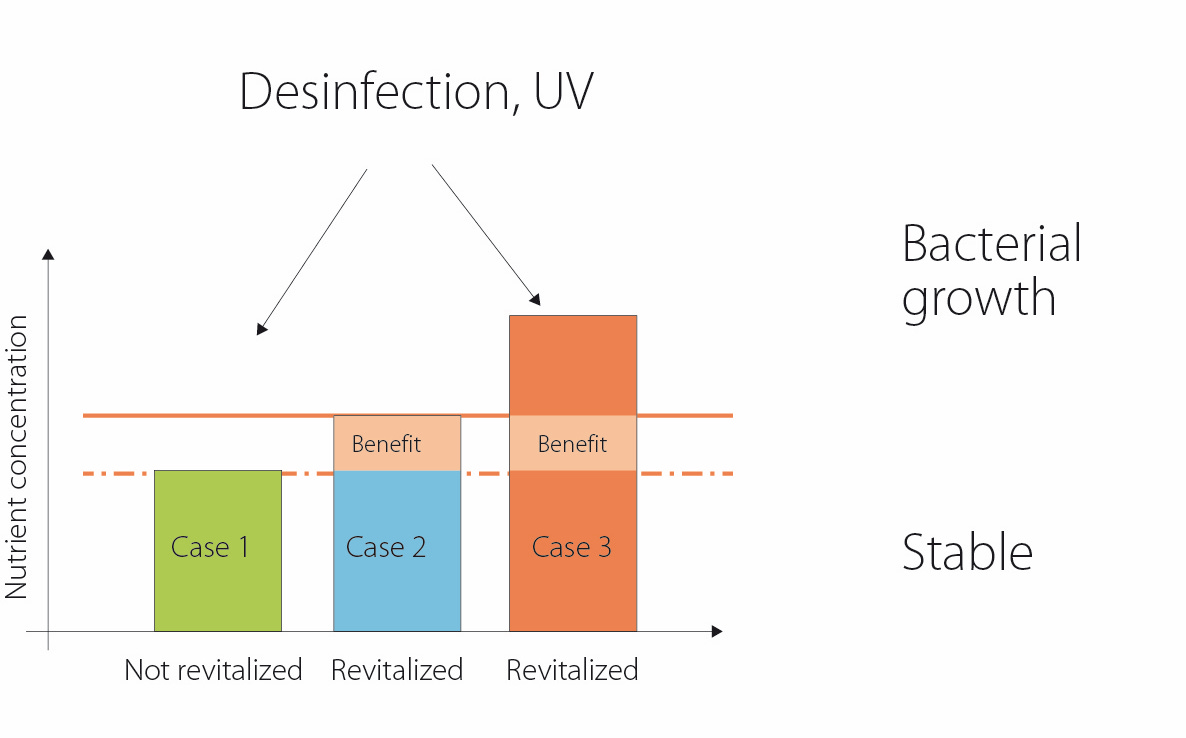
Fig. 11: Example: Microbiological Stability
Bacteria need nutrients and a certain environment to exist and multiply in the water.
In revitalized water, the natural background flora is more active, using up more nutrients and creating a bulwark against unwanted bacteria.
For systems frequently contaminated with large amounts of pollutants, a combination with conventional treatment methods is recommended.
Effects of water revitalization regarding microbiological stability

Thanks to advances in modern measuring technologies, we are starting to get a glimpse of what is happening in water revitalization! Johann Grander was decades ahead of us in understanding these phenomena.
Using the natural strengths
of revitalized water is an
important step towards
sustainability and health.
The stronger and unadulterated water is,
the less treatment it needs.
This saves resources, protects nature,
and also saves a penny.
Our philosophy is to
strengthen the positive forces of water,
helping it maintain a natural balance.
Sources:
(1) Link: https://www.wetsus.nl/research/research-themes/applied-water-physics
(2) Link: https://www.grander.com/international/grander-wasser/wasserforschung/forschungskonzept/externe-forschung/messmethoden
(3) List of universities: https://www.wetsus.nl/research/research-institutes
(4) Coey, J. M. D. (2012). Magnetic water treatment – how might it work? Philosophical Magazine, 92(31), 3857–3865.
(5) Homepage Dr. Elmar C. Fuchs - http://ecfuchs.com/
(6) WETSUS – Applied Water Physics - https://www.wetsus.nl/research/research-themes/applied-water-physics
(7) https://www.mdpi.com/2073-4441/8/3/79/pdf
(8) Strong Gradients in Weak Magnetic Fields Induce DOLLOP Formation in Tap Water
Cees J. N. Buisman and Elmar C. Fuchs , Martina Sammer , Cees Kamp , Astrid H. Paulitsch-Fuchs , Adam D. Wexler
Wetsus, European Centre of Excellence for Sustainable Water Technology, MA Leeuwarden
Received: 21 January 2016; accepted: 23 February 2016; published: 3 March 2016
(9) IPF GmbH
(10) Josh, K.M.; Kamat, P.V. Effect of magnetic field on the physical properties of water. J. Ind. Chem. Soc. 1966, 43,620–622.
(11) Duffy, E.A. Investigation of Magnetic Water Treatment Devices. Ph.D. Thesis, Clemson University, Clemson, SC, USA, 1977.
(12) Lin, I.; Yotvat, J. Exposure of irrigation and drinking water to a magnetic field with controlled power and direction. J. Mag. Magn. Mat. 1990, 83, 525–526.
(13) Higashitani, K.; Kage, A.; Katumura, S.; Imai, K.; Hatade, S. Effects of a magnetic field on the formation of CaCO3 particles. J. Colloid Interface Sci. 1993, 156, 90–95.
(14) Gehr, R.; Zhai, Z.A.; Finch, J.A.; Rao, S.R. Reduction of soluble mineral concentrations in CaSO4 saturated water using a magnetic field. Water Res. 1995, 29, 933–940.
(15) Baker, J.S.; Judd, S.J. Magnetic amelioration of scale formation. Water Res. 1996, 30, 247–260.
(16) Pach, L.; Duncan, S.; Roy, R.; Komarneni, S. Effects of a magnetic field on the precipitation of calcium carbonate. J. Mater. Sci. Lett. 1996, 15, 613–615.
(17) Wang, Y.; Babchin, A.J.; Chernyi, L.T.; Chow, R.S.; Sawatzky, R.P. Rapid onset of calcium carbonate crystallization under the influence of a magnetic field. Water Res. 1997, 31, 346–350.
(18) Parsons, S.A.;Wang, B.L.; Judd, S.J.; Stephenson, T. Magnetic treatment of calcium carbonate scale-effect of pH control. Water Res. 1997, 31, 339–342.
(19) Barrett, R.A.; Parsons, S.A. The influence of magnetic fields on calcium carbonate precipitation. Water Res. 1998, 32, 609–612.
(20) Colic, M.; Morse, D. The elusive mechanism of the magnetic 'memory'of water. Colloid Surface A 1999, 154, 167–174.
(21) Goldsworthy, A.; Whitney, H.; Morris, E. Biological effects of physically conditioned water. Water Res. 1999, 33, 1618–1626.
(22) Coey, J.M.D.; Cass, S. Magnetic water treatment. J. Magn. Magn. Mater. 2000, 209, 71–74.
(23) Hołysz, L.; Chibowski, E.; Szcze´s, A. Influence of impurity ions and magnetic field on the properties of freshly precipitated calcium carbonate. Water. Res. 2003, 37, 3351–3360.
(24) Kobe, S.; Draži´c, G.; McGuiness, P.J.; Meden, T.; Sarantopolou, E.; Kollia, Z.; Sefalas, A.C. Control over nanocrystalization in turbulent flow in the presence of magnetic fields. Mater. Sci. Eng. 2003, 23, 811–815.
(25) Knez, S.; Pohar, C. The magnetic field influence on the polymorph composition of CaCO3 precipitated from carbonized aqueous solutions. J. Colloid Interface Sci. 2005, 281, 377–388.
(26) Fathia, A.; Mohamed, T.; Claude, G.; Maurin, G.; Mohamed, B.A. Effect of a magnetic water treatment on homogeneous and heterogeneous precipitation of calcium carbonate. Water Res. 2006, 40, 1941–1950.
(27) Li, J.; Liu, J.; Yang, T.; Xiao, C. Quantitative study of the effect of electromagnetic field on scale deposition on nanofiltration membranes via UTDR. Water Res. 2007, 41, 4595–4610.
(28) Katsir, Y.; Miller, L.; Aharanov, Y.; Jacob, E.B. The effect of rf-irradiation on electrochemical deposition and its stabilization by nanoparticle doping. J. Electrochem. Soc. 2007, 154, 249–259.
(29) Hołysz, L.; Szcze´s, A.; Chibowski, E. Effects of a static magnetic field on water and electrolyte solutions. J. Colloid Interface Sci. 2007, 316, 996–1002